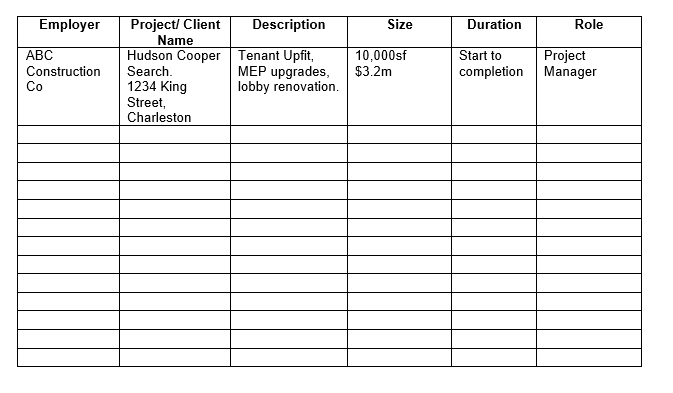Story by Gemma Beasley / October 3, 2022

Project lists are an essential part of applying for new jobs in construction. They can make the difference between securing an interview or not and can help improve your performance in interviews because you will have real-life examples you can draw from and talk through.
Firstly – Create a separate document
Have your resume as one document and your project list as a separate one. This is better than continuing to add extra pages to your resume and will be easier for a potential employer to read and digest. In the example I send to candidates, I break it down into these six columns:

It’s never too early (or late) to create a project list
Graduates/ entry-level – Adding each project to your list from the start of your career will save you time as you progress throughout your career and allow you to share a project list with a potential employer quickly. Add projects you worked on during internships or summer breaks, too; it will all help build a picture of your experience, even at the very start of your career.
More experienced professionals – even if you aren’t looking for a new job and have no intention of doing so anytime soon, it’s still worth putting together a project list and keeping it updated. Many of you will have had one put together for you by your current employer, and it is an excellent way to help you succeed when your team is attending client interviews by drawing on your previous experience.
Regardless of how much or little experience you have, if you add to this list every time you complete a project, you will save yourself lots of time (and stress) in the future.
How many projects should I include?
Include all job sizes and sectors, don’t leave anything out when you start. This will show versatility and breadth of experience and make it easier for you to pick out specific examples based on the company and job(s) you apply to. You can then highlight those as part of the application and interview process.
If you’d like further information on this, or to request this in a word document please send an email to gemma@hudsoncoopersearch.com and I’ll send you the template.
Construction recruitment agencies are common. Strong partnerships rooted in trust and good communication are rare. Learn why we’re the latter.
Learn MorePut your career in the hands of recruiters who know your worth. We focus on your long term success and strive to make your job search process feel effortless.
Learn MoreIf you've been tracking the pulse of the construction industry lately, you've likely noticed that wage discussions are all the rage. The workforce, from fresh-faced...
If you've been on a construction site lately, you may have noticed the fresh-faced workers sporting toolbelts don't come cheap. Clients are sounding the alarm...
Even for high-profile, big-budget construction projects, recruiting qualified labor has become an immense challenge. Time and again, firms are met with rejection from experienced professionals...
Every construction leader is tasked with finding and attracting talent to support your company's growth. The trouble is, you’re supposed to do this while juggling...
The shackles are finally coming off. For millions of American workers bound by restrictive non-compete agreements, the Federal Trade Commission's groundbreaking decision to ban such...
Landing a second interview is huge, but don't think you're home free. The industry is ultra-competitive, especially when hiring at senior level. Don’t rely on...
A client recently shared a story that made me rethink some long-held beliefs around employee turnover. They told me about a superintendent named Mike, who...
PWC is a national nonprofit organization that seeks to support, advance, and connect women and promote diversity within the architecture, engineering, construction, (AEC) and related...
When Mike's daughter was born, he was anxious about balancing his construction foreman job with fatherhood. His company offered only 1 week of paid leave,...
As contractors sound alarms over skilled labor shortages, they repeatedly overlook a hidden asset – working moms. While women make up only 10% of the...
Fatigue from years of physical labor sets in. Noisy chaos frays your nerves. You’ve maxed out your pay scale. You’re struggling to see opportunities for...
Buildings account for nearly 40% of global emissions, putting immense pressure on construction firms to prioritize sustainable and net-zero practices. Cities like New York and...
Bonuses work. When done right. While variable pay plans have tremendous potential to accelerate results and incentivize top talent, without proper structuring and communication, they...
As a recruiter in the trenches, I’ve seen the construction industry’s hiring crisis up close. Project managers are slammed, desperately piecing together teams at the...
You've made it to the final round of interviews with your chosen construction firms. After months of rigorous screening, you've proven yourself again and again....
The COVID-19 pandemic brought construction sites grinding to a halt. Teams accustomed to hands-on collaboration were forced into remote work overnight. Many adapted well during...
When clouds roll in, it’s tempting to hunker down and pray for sun. But storms can also offer firms a chance to fortify foundations and...
Any construction company's reputation hinges on the caliber of its craftsmanship. This applies not only to client projects, but also to the employer brand you...
The threat of being replaced can fill even the most seasoned leaders with dread and self-doubt. As new talent arrives, it's only natural to feel...
Every time we talk to a candidate about your company, and the position you need to fill, we have to be able to articulate why...
Recruiting is a transitory process that can feel uncertain – even when the conditions that surround it are perfect. But as staffing specialists within the...
Project lists are an essential part of applying for new jobs in construction. They can make the difference between securing an interview or not and...
Robotics in construction are on the rise, and new market research shows that the sector is expected to swell in value as contractors look to...